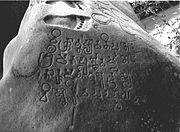| Some of this article's listed sources may not be reliable. Please help improve this article by looking for better, more reliable sources. Unreliable citations may be challenged and removed. (January 2023) (Learn how and when to remove this message) |
| Pallava script | |
|---|---|
 'Pallava' in Pallava script 'Pallava' in Pallava script | |
| Script type | Abugida |
| Time period | 4th century CE to Present |
| Direction | Left-to-right |
| Languages | Telugu, Kannada, Konkani, Marathi, Tamil, Old Khmer, Old Malay, Burmese, Thai, Sinhala, Lao, Mon, Balinese, etc. |
| Related scripts | |
| Parent systems | Egyptian hieroglyphs
|
| Child systems | Mon-Burmese, Khmer, Cham, Kawi |
| Sister systems | Vattezhuthu, Kolezhuthu |
| This article contains phonetic transcriptions in the International Phonetic Alphabet (IPA). For an introductory guide on IPA symbols, see Help:IPA. For the distinction between , / / and ⟨ ⟩, see IPA § Brackets and transcription delimiters. | |
| Brahmic scripts |
|---|
| The Brahmi script and its descendants |
| Northern Brahmic |
| Southern Brahmic |
The Pallava script, or Pallava Grantha, is a style of Grantha script named after the Pallava dynasty of Southern India (Tamilakam) and is attested to since the 4th century CE. In India, the Pallava script evolved from Tamil-Brahmi. The Grantha script originated from the Pallava script. Pallava also spread to Southeast Asia and evolved into scripts such as Balinese, Baybayin, Javanese, Kawi, Khmer, Lanna, Lao, Mon–Burmese, New Tai Lue, Sundanese, and Thai. This script is the sister of the Vatteluttu script which was used to write Tamil and Malayalam in the past.
Epigrapher Arlo Griffiths argues that the name of the script is misleading as not all of the relevant scripts referred to have a connection with the Pallava dynasty. He instead advocates that these scripts be called Late Southern Brāhmī scripts.
History
During the rule of the Pallavas, the script accompanied priests, monks, scholars, and traders into Southeast Asia. Pallavas developed the Pallava script based on Tamil-Brahmi. The main characteristics of the newer script are aesthetically matched and fuller consonant glyphs, similarly visible in the writing systems of Chalukya, Kadamba, and Vengi at the time of Ikshvakus. Brahmi's design was slightly different from the scripts of Cholas, Pandyas, and Cheras. Pallava script was the first significant development of Brahmi in India, combining rounded and rectangular strokes and adding typographical effects, and was suitable for civic and religious inscriptions. Kadamba-Pallava script evolved into early forms of Kannada and Telugu scripts. Glyphs become more rounded and incorporate loops because of writing upon leaves and paper.
The script is not yet a part of Unicode but proposals have been made to include it. In 2018, Anshuman Pandey made a proposal.
Characteristics
The form shown here is based on examples from the 7th century CE. Letters labeled * have uncertain sound value, as they have little occurrence in Southeast Asia.
Consonants
Each consonant has an inherent /a/, which will be sounded if no vowel sign is attached. If two consonants follow one another without intervening vowel, the second consonant is made into a subscript form, and attached below the first.
| ka | kha | ga | gha | nga |
|---|---|---|---|---|
| ca | cha | ja | jha* | nya |
| ṭa | ṭha* | ḍa | ḍha* | ṇa |
| ta | tha | da | dha | na |
| pa | pha | ba | bha | ma |
| ya | ra | la | va | |
| śa | ṣa | sa | ha | |
Independent Vowels
| a | ā | i | ī | u | e | o | ai* | au* |
|---|---|---|---|---|---|---|---|---|
Examples
-
Kadamba-Pallava script
-
 Pallava script at the 8th century Kailasanatha temple in Kanchipuram, Tamil Nadu.
Pallava script at the 8th century Kailasanatha temple in Kanchipuram, Tamil Nadu.
-
 The Ciaruteun inscription, a 5th-century Pallava stone inscription discovered in Indonesia
The Ciaruteun inscription, a 5th-century Pallava stone inscription discovered in Indonesia
-
One of the oldest inscriptions discovered in Indonesia, the Yūpa inscriptions of King Mulavarman, king of Kutai Martadipura written in the 4th century AD
Unicode
A proposal to encode the script in Unicode was submitted in 2018.
References
- ^ Griffiths, Arlo (2014). "53-57". LOST KINGDOMS: Hindu-Buddhist Sculpture of Early Southeast Asia. New York: The Metropolitan Museum of Art. ISBN 9781588395245.
- Salomon, Richard (1998). Indian Epigraphy. p. 40.
- "Grantha alphabet". Retrieved 13 September 2018.
- "Balinese alphabet". Retrieved 13 July 2019.
- "Tagalog". Retrieved 13 September 2018.
- "Javanese alphabet". Retrieved 13 September 2018.
- "Kawi alphabet". Retrieved 13 September 2018.
- "Khmer". Retrieved 13 September 2018.
- "Lanna alphabet". Retrieved 13 September 2018.
- "Lao". Retrieved 13 September 2018.
- "Mon". Retrieved 13 September 2018.
- "New Tai Lue script". Retrieved 13 September 2018.
- "Sundanese". Retrieved 13 September 2018.
- "Thai". Retrieved 13 September 2018.
- Coulmas, Florian (1999). The Blackwell Encyclopedia of Writing Systems. Blackwell Publishing. p. 542. ISBN 9780631214816.
- http://www.skyknowledge.com/burnell-plate4.gif
- ^ "Pallava script". Skyknowledge.com. 2014-02-02. Retrieved 2014-03-13.
- ^ Pandey, Anshuman. (2018). Preliminary proposal to encode Pallava in Unicode.
Bibliography
- Sivaramamurti, C, Indian Epigraphy and South Indian Scripts. Bulletin of the Madras Government Museum. Chennai 1999
External links
 Media related to Pallava script at Wikimedia Commons
Media related to Pallava script at Wikimedia Commons